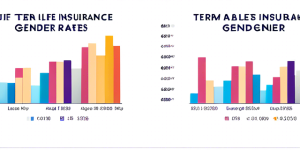Term Life Insurance Rates 2024

Hey there, savvy saver! Are you scratching your head over term life insurance rates? You’re not alone. It’s like trying to decipher a secret code, right? Well, grab a cup of coffee and get comfy, because we’re about to unravel this mystery together. By the time you finish reading, you’ll be a pro at understanding term life insurance rates. Let’s dive in!
Why Term Life Insurance? The Budget-Friendly Guardian Angel
Before we jump into the nitty-gritty of rates, let’s talk about why term life insurance is the go-to choice for many. Think of term life insurance as renting a financial safety net. You pay for coverage over a specific period – usually 10, 20, or 30 years. It’s like having a guardian angel on a contract!
Why do people love it? It’s simple and affordable. You get a hefty payout (called a death benefit) for a relatively low premium. It’s perfect for those peak years when you’ve got a mortgage to pay off or kids to put through college.
According to the Insurance Information Institute, term life is the most common type of life insurance. No wonder – it’s like getting caviar protection on a tuna fish budget!
The Anatomy of Term Life Insurance Rates: What Makes Them Tick?
Now, let’s dissect those rates. What exactly goes into determining how much you’ll pay? It’s not just pulled out of a hat, you know!
- Your Age: The younger you are, the lower your rates. It’s one of those rare times when being young really pays off!
- Your Health: The healthier you are, the less risky you are to insure. Those kale smoothies might just pay off!
- Your Gender: On average, women pay less than men. Ladies, chalk one up for longevity!
- Your Lifestyle: Skydiving every weekend? Expect higher rates. Insurance companies aren’t big fans of adrenaline junkies.
- Your Family History: Some medical conditions run in families, and insurers take note.
- Policy Length and Amount: Longer terms and higher coverage amounts mean higher premiums. It’s like buying in bulk – more product, higher price.
The Price Tag: What Can You Expect to Pay?
Alright, let’s talk numbers. How much does this peace of mind actually cost? Well, it varies widely, but let’s look at some ballpark figures.
According to Policygenius, a healthy 30-year-old male might pay around $30 per month for a 20-year, $500,000 policy. That’s less than your monthly streaming subscriptions!
But remember, these are just averages. Your rate could be higher or lower depending on your unique factors. It’s like fingerprints – no two policies are exactly alike.
Age and Term Life Insurance Rates: The Time is Now!

Let’s talk about the elephant in the room – age. When it comes to term life insurance, age isn’t just a number. It’s a major factor in your rates.
Here’s the deal: the younger you are when you buy a policy, the lower your rates will be. It’s like getting in on a sale early – the best deals go fast!
Why? Well, from an insurer’s perspective, younger people are less likely to, well, kick the bucket during the policy term. Morbid, I know, but that’s the insurance game for you.
Let’s break it down:
- In your 20s and 30s: This is prime time for locking in low rates. You’re likely in good health and have a long life expectancy ahead.
- In your 40s and 50s: Rates start to climb, but they’re still manageable. It’s like catching a sale on the last day – not the best deal, but still worth it.
- 60 and beyond: Rates can get steep, but don’t let that deter you if you need coverage. Some protection is better than none!
Remember, once you lock in a rate, it stays the same for the entire term. So buying early is like freezing time – at least as far as your insurance premiums are concerned!
Health and Term Life Insurance Rates: The Wellness Factor
Alright, health nuts, this is your time to shine! When it comes to term life insurance rates, your health is a major player. It’s like your health is auditioning for a starring role in determining your premiums.
Insurance companies love healthy people. Why? Because healthy people are less likely to make a claim during the policy term. It’s like betting on a star athlete – they’re more likely to win the game.
Here’s how your health impacts your rates:
- Weight: Being within a healthy BMI range can lower your rates. It’s like getting a discount for being fit!
- Blood Pressure and Cholesterol: Keep these in check, and your wallet will thank you.
- Smoking: This is a big one. Smokers can pay 2-3 times more than non-smokers. Quitting doesn’t just save your lungs – it saves you money!
- Chronic Conditions: Diseases like diabetes or heart conditions can increase your rates. But well-managed conditions might not hit your wallet as hard.
- Family History: Some things are out of your control, like your family medical history. But a healthy lifestyle can often offset genetic risks.
Here’s a pro tip: some insurers offer better rates if you show evidence of a healthy lifestyle. So those gym selfies might actually pay off!
Gender and Term Life Insurance Rates: Battle of the Sexes

Ladies, here’s some good news – when it comes to term life insurance rates, you’ve got an edge. It’s one of those rare instances where the ‘pink tax’ works in reverse!
On average, women pay less for term life insurance than men. Why? It all comes down to life expectancy. Women generally live longer than men, which means they’re less likely to pass away during the policy term. Insurance companies love that kind of statistic!
According to the National Center for Health Statistics, the life expectancy for women in the US is about 5 years longer than for men. That’s a significant difference in the eyes of an insurer.
But guys, don’t despair. While you might pay a bit more, term life insurance is still an incredibly affordable way to protect your loved ones. And remember, these are just averages – your individual rate will depend on many factors, not just your gender.
Lifestyle and Term Life Insurance Rates: Living on the Edge
Are you an adrenaline junkie? A world traveler? Or more of a couch potato? Your lifestyle plays a big role in your term life insurance rates. It’s like your life is a movie, and the insurance company is the critic – they’re rating how risky your performance is!
Here’s how different lifestyle factors can impact your rates:
- Occupation: Some jobs are riskier than others. If you’re a desk jockey, you’re in luck. But if you’re a firefighter or deep-sea welder, expect higher rates.
- Hobbies: Love skydiving or rock climbing? These high-risk hobbies can bump up your premiums. It’s the price of living life on the edge!
- Travel: Frequent trips to high-risk countries can increase your rates. It’s not just about how you live, but where you live (or visit) too.
- Driving Record: Lead foot on the gas pedal? Multiple speeding tickets or accidents can rev up your rates.
- Alcohol and Drug Use: Heavy drinking or drug use is a red flag for insurers. Sobriety isn’t just good for your health – it’s good for your wallet too!
Remember, insurance companies are all about assessing risk. The riskier your lifestyle appears, the higher your premiums are likely to be. But don’t let that stop you from living your best life – just be prepared for the insurance impact!
Policy Length and Amount: Sizing Up Your Coverage
When it comes to term life insurance rates, size matters – both the size of your policy and how long it lasts. It’s like buying a car – a Ferrari costs more than a Fiat, and a 5-year lease costs more than a 3-year one.
Let’s break it down:
Policy Length:
- 10-year term: Shortest and typically cheapest
- 20-year term: Middle ground, popular for young families
- 30-year term: Longest common term, highest rates but longest coverage
Coverage Amount:
- $100,000: Might cover final expenses and some debts
- $500,000: Popular choice for many families
- $1 million and up: Larger policies for higher incomes or more complex needs
Here’s the deal: longer terms and higher coverage amounts mean higher premiums. But remember, locking in a rate when you’re young can save you money in the long run, even if you go for a longer term.
Pro tip: Some people “ladder” their policies. That means buying multiple policies of different lengths and amounts to match their changing needs over time. It’s like a custom-tailored insurance suit!
Shopping for Rates: How to Get the Best Deal
Alright, bargain hunters, this is your time to shine! Shopping for term life insurance rates is a bit like hunting for the best deal on Black Friday – with the right strategy, you can score big!
Here’s your game plan:
- Compare, Compare, Compare: Get quotes from multiple insurers. It’s like trying on shoes – you need to find the perfect fit.
- Use an Independent Agent: They can shop around for you and often have access to more options.
- Consider Your Health Class: Insurers use different health classifications. You might be “Standard” with one company but “Preferred” with another.
- Look for Rate Reconsideration: Some companies will lower your rate if your health improves after you buy a policy.
- Bundle Policies: Sometimes you can get a discount if you buy life insurance along with other policies, like auto or home insurance.
- Pay Annually: If you can swing it, paying your premium annually instead of monthly often comes with a discount.
- Buy Young: We’ve said it before, but it bears repeating – the younger you are, the lower your rates will be.
Remember, the cheapest policy isn’t always the best. Make sure you’re getting the coverage you need from a reputable company. It’s like buying a parachute – you want the best, not just the cheapest!
The Medical Exam: Friend or Foe?
Ah, the medical exam. It’s the part of getting life insurance that makes many people squirm. But here’s a secret – it can actually be your best friend when it comes to getting great rates!
The medical exam is your chance to prove to the insurance company that you’re a low-risk customer. It’s like auditioning for a part in a play – this is your moment to shine!
Here’s what to expect:
- Height and Weight: They’ll check your BMI.
- Blood Pressure: Time to show off those meditation skills!
- Blood and Urine Tests: These check for various health conditions and drug use.
- Medical History Review: Be honest – they’ll find out anyway!
Pro tip: Schedule your exam for the morning and fast for 8-12 hours before. This can lead to better results on your blood tests.
Some companies now offer “no-exam” policies. These can be convenient, but they’re often more expensive. It’s like buying a car without a test drive – easier, but you might pay more for the convenience.
The Fine Print: Understanding Policy Details
Alright, it’s time to put on your reading glasses and dive into the fine print. I know, I know – about as exciting as watching paint dry, right? But trust me, understanding these details can save you big bucks and major headaches down the road.
Here are some key things to look for:
- Renewable Terms: Can you renew the policy after the term ends? At what rate?
- Convertible Policies: These allow you to convert your term policy to a permanent one without a new medical exam.
- Riders: These are add-ons to your policy. Common ones include:
- Accelerated Death Benefit: Allows you to access your death benefit if you become terminally ill.
- Waiver of Premium: Waives your premiums if you become disabled.
- Exclusions: What isn’t covered? Suicide within the first two years is a common exclusion.
- Grace Period: How long do you have to make a payment if you miss the due date?
Remember, cheaper isn’t always better if it means sacrificing important features. It’s like buying a car – sometimes it’s worth paying a bit more for better safety features or a longer warranty.
The Future of Term Life Insurance Rates: Crystal Ball Gazing
What does the future hold for term life insurance rates? While I haven’t perfected my crystal ball gazing skills just yet, we can make some educated guesses based on current trends.
- Personalized Pricing: With the rise of wearable tech and big data, we might see more personalized pricing based on individual health and lifestyle data.
- Simplified Underwriting: More companies are offering policies with no medical exam, using data and AI to assess risk instead.
- Impact of Climate Change: As climate change affects life expectancy and health risks, we might see this reflected in insurance rates.
- Economic Factors: Interest rates and the overall economy can impact insurance rates. When interest rates are low, insurance companies may need to charge higher premiums to ensure they can pay future claims.
- Regulatory Changes: Any changes in insurance regulations could impact rates.
Remember, these are just predictions. The insurance industry can be as unpredictable as a game of Monopoly – you never know when you’ll land on Park Place!
Making the Decision: Is Term Life Insurance Right for You?
So, we’ve covered a lot of ground. But the big question remains – is term life insurance the right choice for you? Let’s break it down:
Term life might be right for you if:
- You need coverage for a specific period (like until your kids are grown or your mortgage is paid off)
- You want the most coverage for the lowest price
- You’re on a tight budget but still want to protect your family
It might not be the best choice if:
- You want coverage that lasts your entire life
- You’re interested in using life insurance as an investment vehicle
- You have long-term dependents (like a child with special needs)
Remember, there’s no one-size-fits-all answer. It’s like choosing a car – what works for your neighbor might not work for you.
Conclusion: Wrapping Up Our Term Life Insurance Rate Adventure
Whew! We’ve covered a lot of ground, haven’t we? From understanding what goes into term life insurance rates to shopping for the best deals, you’re now armed with the knowledge to make an informed decision.
Remember, term life insurance is all about peace of mind. It’s knowing that if the unexpected happens, your loved ones will be financially protected. And the best part? This peace of mind often comes at a price that’s less than your monthly coffee budget!
As you move forward in your insurance journey, keep in mind that rates can vary significantly between companies. Don’t be afraid to shop around, ask questions, and seek professional advice if needed. After all, this is an important decision that impacts your family’s financial future.
Whether you’re a young parent looking to protect your growing family, a homeowner wanting to cover your mortgage, or simply someone who wants to leave a legacy, term life insurance can be an affordable way to achieve your goals.
So, are you ready to take the next step in securing your family’s financial future? Remember, the best time to plant a tree was 20 years ago. The second best time is now. The same goes for life insurance – the sooner you act, the better rates you’re likely to secure.
Now, go forth and conquer those term life insurance rates! Your future self (and your loved ones) will thank you.
FAQs
- Can I change my term life insurance coverage amount after I’ve purchased a policy? In most cases, yes. Many insurers allow you to increase or decrease your coverage amount. Increasing coverage usually requires additional underwriting and may result in higher premiums. Decreasing coverage is generally simpler and can lower your premiums.
- What happens if I outlive my term life insurance policy? If you outlive your policy, the coverage simply ends. You won’t receive any money back (unless you have a return of premium policy). However, many policies offer the option to renew (usually at a higher rate) or convert to a permanent policy.
- Can I have multiple term life insurance policies? Absolutely! In fact, some people find it beneficial to have multiple policies. For example, you might have a 30-year policy to cover your mortgage and a 20-year policy to cover your children’s education expenses.
- How does my occupation affect my term life insurance rates? Certain occupations are considered riskier than others and can result in higher premiums. For example, firefighters, pilots, and offshore oil workers typically pay higher rates than office workers. However, the impact varies by insurer, so it’s worth shopping around.
- Are term life insurance premiums tax-deductible? Generally, no. The premiums you pay for

